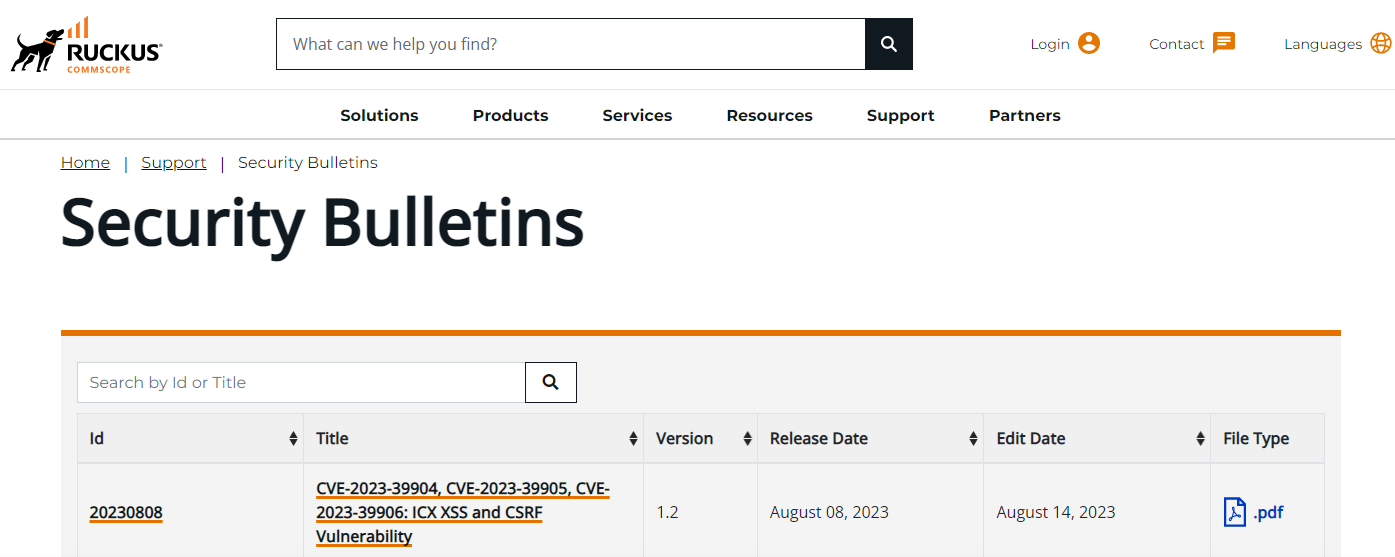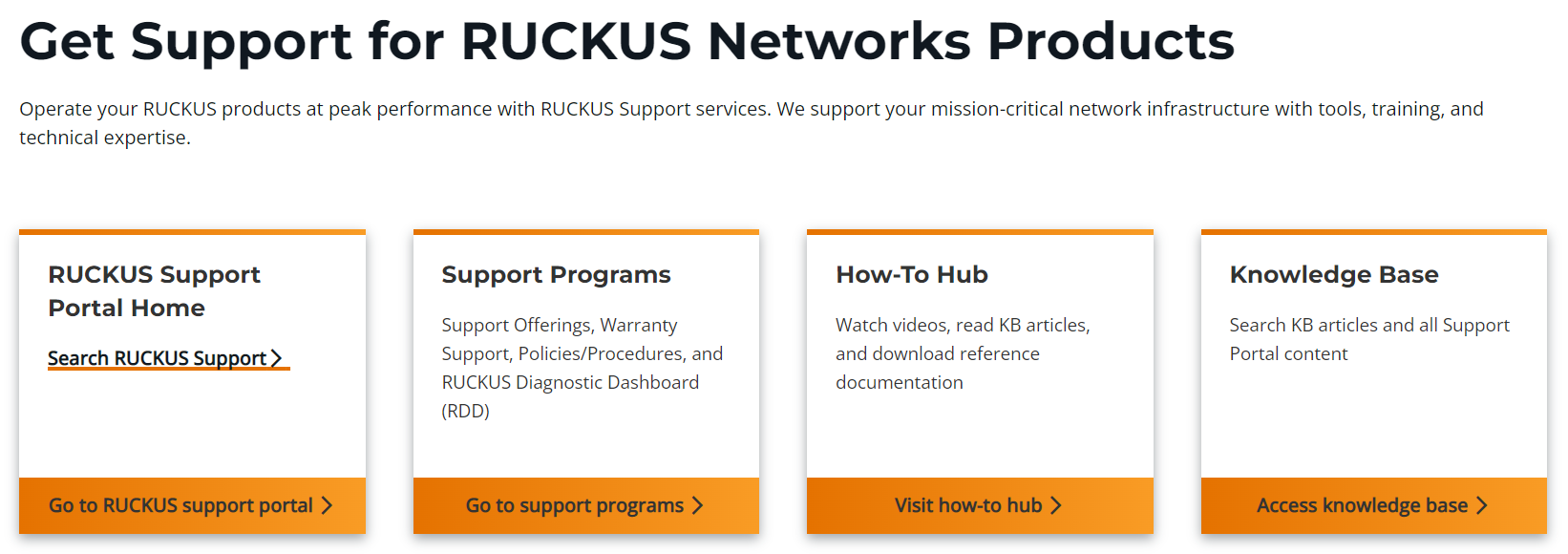Bienvenido a RUCKUS Networks, parte de la cartera líder mundial de soluciones de redes de CommScope. Más información.
Technology, and the ability to get around that technology, is constantly changing, so RUCKUS® security has to help you change with it. As attackers become more sophisticated, it becomes that much more important to keep abreast of the latest security concerns and bulletins. In addition, the basics of security defense, discussed in previous RUCKUS Networks blogs, become even more important so you have sufficient information to address both old and new threats. RUCKUS takes security seriously and provides up-to-date websites, software, and content to keep you aware of needed changes, patches, and security concerns.
Importance of firmware and software updates
Monitoring security bulletins, security advisories, threat intelligence, and other sources of information for potential security issues is important for proactively protecting your network against known and evolving issues such as remote code execution, botnets, ddos, and other related vulnerabilities. But, there is also a place for letting process and controls assist with that responsibility. By instituting regular updates to your firmware and software, you can maintain network security, address performance issues, and protect against emerging vulnerabilities just by keeping your network up-to-date.
How to check for Security Bulletins and vulnerabilities
Security bulletins are a primary means of keeping up with actual vulnerabilities in the network. These bulletins will list out the name of the vulnerability, description, what could be allowed by the vulnerability, and patches recommended to fix the issue. In addition, there are national or technology-specific registries that you can check to stay current.
Steps to check for the latest RUCKUS Security Bulletins
To access the latest security bulletins and advisories, visit the official RUCKUS website maintained both externally and within the RUCKUS support portal. The websites contain helpful information for RUCKUS customers to read about how to address known issues via a specific bulletin. Links for each are below:
- RUCKUS Security Bulletins within the RUCKUS support portal
- Externally available RUCKUS Security Bulletins
How do you check CISA and NIST for common vulnerability events (CVEs)?
In addition, it is a good idea to check on known vulnerabilities, also known as common vulnerability events (CVEs). The U.S. government maintains a repository of known vulnerabilities and associated severity levels (known as CVSS severity).
The Cybersecurity and Infrastructure Security Agency (CISA) also maintains a database of cybersecurity alerts and advisories that is updated regularly. It is searchable by advisory type, release year, or vendor, making it easy to lookup the latest on any product in your network.
Reporting a RUCKUS security issue
Prompt resolution of vulnerabilities and threats is critical for all network owners. That is why reporting potential security issues to RUCKUS is an important part of making your network more secure. Reporting an issue fosters collaboration for proactive security management and also allows you to find out if what you are experiencing is a security gap or is already addressed by a known issue (and patch). Also, if there are any immediate mitigation steps, you can find that out when reporting the issue or searching the bulletin database.
What is the procedure to report a RUCKUS product security issue?
RUCKUS publishes an easy-to-follow process for reporting a potential security issue. The RUCKUS Product Security Team takes each report of a potential security issue seriously, as they are responsible for researching, analyzing, and responding to security incident reports involving RUCKUS products. Following this process allows RUCKUS to engage its network of security researchers, government entities, consultants, industry security organizations, outside entities, and other vendors to determine if an issue is security-related, the extent of that issue, and means of addressing it.
To let RUCKUS know about an issue, follow the defined security issue reporting process captured in the RUCKUS security incident response policy and send a message to the email alias listed. Makes sure to provide a detailed description of the issue you believe you are facing.
Replace End of Life Product in your environment
Product that is no longer supported, or end of life, often will not receive the most current security updates. Keeping end-of-support Wi-Fi® access points (APs), switches, or software in your environment opens you up to particular security issues and network outages that are generally addressed by patches to newer, actively supported product. Therefore, a best practice is to make sure you are not running any equipment or software that is no longer supported since it is possible this equipment won't receive critical security updates or be monitored actively (or as actively) as currently supported networking gear.
If you are unsure, check out the list of RUCKUS products that are end of life to see if any of your equipment is no longer supported and needs to be replaced. Contact a RUCKUS sales representative if you find yourself in this situation and need to refresh your network.
Keep active support for products in your network
Just as important as keeping your products current is making sure your products are under an active support contract. The network edge is where a lot of processing and connectivity now happens, and one of the best defenses is for the firmware and software to be up-to-date. To be able to install the latest firmware and patches, you need an active support contract for software and maintenance. RUCKUS provides different levels of support, and you can renew existing support, start new support, or change levels of support as fits your business needs. You can check out more information on the RUCKUS support page.
Conclusion
Staying up-to-date with firmware and software updates and utilizing currently supported equipment are crucial for maintaining the security of your RUCKUS (or any vendor) devices. It allows for vulnerabilities or bugs to be addressed promptly, reducing the risk of cybersecurity threats. Likewise, keeping up-to-date on the known security issues by monitoring security bulletins is a key part of preventing security holes. To check for the latest security bulletins, visit the RUCKUS website and navigate to the support section. Remain informed about the latest security notices to stay proactive in protecting your network and devices. If you come across a security issue with your RUCKUS product, it is essential to report it immediately. Reporting security issues helps RUCKUS address and resolve the problem effectively, promoting the safety of RUCKUS customers. Follow the procedure outlined on the website to report any security concerns. Your contribution in reporting such issues is invaluable in maintaining a secure network environment for all users.
FAQ
How can RUCKUS One help you to perform security updates automatically?
RUCKUS One™ can automatically update firmware in your network through its cloud AI Ops. It identifies devices that require updates, downloads and installs the necessary files, and schedules the updates during low-traffic periods to minimize disruptions. This automation helps keep your network devices are up-to-date, enhancing performance and security.
Can other RUCKUS products help you keep your network up-to-date?
RUCKUS SmartZone™ can allow you to schedule firmware updates for your network. You, as the administrator, still need to configure and schedule the different zones and firmware versions for those zones to be updated, so it is not a completely automatic process. However, it does provide a level of control and flexibility that, coupled with due diligence to remain up-to-date on firmware and patches, can help to protect your network.
© 2024 CommScope, Inc. All rights reserved. CommScope and the CommScope logo are registered trademarks of CommScope and/or its affiliates in the U.S. and other countries. For additional trademark information see https://www.commscope.com/trademarks. Wi-Fi is a trademark of the Wi-Fi Alliance. All product names, trademarks and registered trademarks are property of their respective owners.
Get ahead with RUCKUS Networks!
Sign up for exclusive insights from RUCKUS Networks.














